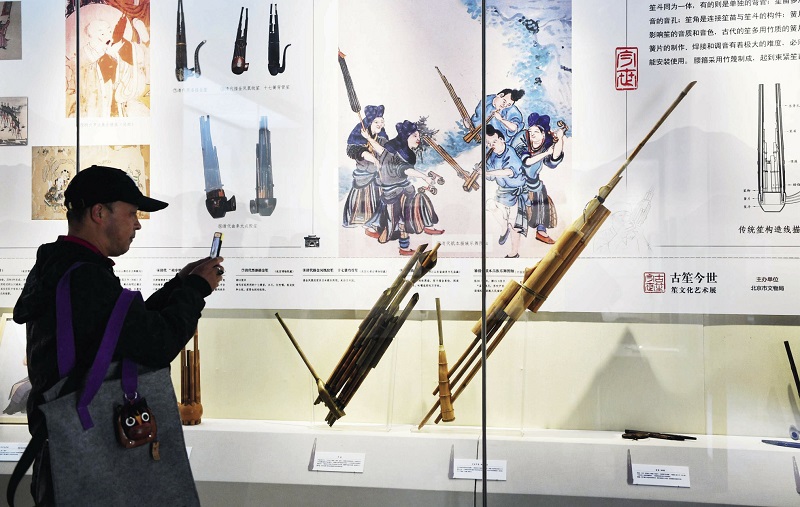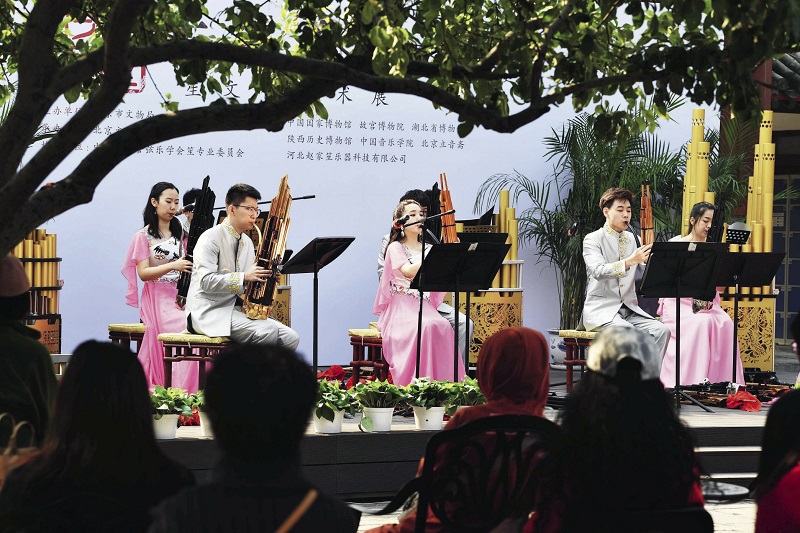Perhaps you may have been impressed by the grand tunes played on a pipe organ, enjoyed joyful music produced by accordions, or maybe you have tried to play some tune on a harmonica by yourself. Did you know that all these instruments would not be what they are without the genius invention of reeds used on the sheng, a traditional Chinese free reed instrument, which inspired most of the other free reed instruments around the world?
The sheng is deemed as the initial inspiration for other free reed instruments outside China. It spread to West Asia during China’s Northern Dynasty (386-581) and Tang Dynasty (618-907) and then appeared in Europe around the 17th century. The organ, accordion, and harmonica are all decedents of the sheng.

A visitor at an exhibition on the sheng passes by a collection of shengs, including real objects and images.
A Unique Instrument
The sound of the sheng is made by the vibration of reeds and chambers produced by exhaling or inhaling into the mouthpiece and pressing specific holes on the pipes. It is the only Chinese traditional instrument whose sound can be made while the player is both breathing in and breathing out. Even more amazing than this, it is a polyphonic instrument which means it can produce several notes at the same time.
Primarily made from bamboo sticks, the sheng is composed of five main parts. The tobacco-pipe-shaped chamber at the bottom is called the sheng chest; the component at the front is the mouthpiece; there are sets of bamboo sticks called sheng pipes placed in the chest; each pipe has one round opening which is called a finger-hole. In addition, one reed is placed on each piece of bamboo pipe, enabling each reed to produce one note.
Techniques used in making the sheng are very complicated. In addition to the exceptional techniques required in making those small reeds out of bamboo, it needs skilled hands to trim them into the exact right pitch.
In the beginning, a sheng had 13 or 14 reeds, later some had 17, 21, 24, 26 or even 27 reeds, but all of them were considered traditional shengs. After undergoing continuous reforms and attempted changes by generations of musicians, a number of alterations were made to the sheng, ranging from its tone, volume, and note arrangements, as well as its appearance and weight.
Shengs are polyphonic instruments and can play multiple notes simultaneously, making it an ideal accompaniment instrument. There is a saying that “sheng and wind instruments never leave each other alone.” For example, the engagement of sheng complements the performance of flutes and suonas.
Ups and Downs
According to certain Chinese legends, the goddess Nüwa who created humans out of mud invented the sheng. The Book of Documents (Shangshu) and The Classic of Poetry (Shijing) contain the earliest written record of the sheng. During the Pre-Qin Era, sheng was the major wind instrument played in China. However, after the rise of plucked stringed instruments, the popularity of the sheng declined and it became an accompaniment instrument in Chinese orchestras that performed talking and singing arts. After that, its presence in the imperial court also began to dwindle and was passed on mainly by ordinary people. By the mid-20th century, sheng performance reached its lowest point.
After the founding of the People’s Republic of China in 1949, the development of the sheng began to take an upward turn. A number of musical schools included sheng playing as part of their curriculum and generations of exceptional sheng players emerged to meet the demands of the new era.
The traditional sheng was unable to play an eight-note scale until the 1950’s when Zhao Zhende invented a pair of 26-reed sheng. He categorized the reeds into several groups based on the pitch, and added keys for high notes, solving the obstacles of modulation, breathing and scale arrangement. This invention served as a significant contribution to the modern evolvements of sheng. There are also many other breakthroughs in sheng developments such as heat preservation component, swirling sheng chest and movable caps.
Following those changes, in the 20th century, a group of shengs covering high, mid, and low keys were made to better serve the needs of orchestras.
The traditional type of sheng cannot meet the demands of orchestras in such aspects as chords and choruses, but the contemporary shengs can make it. Apart from being an accompaniment instrument, shengs also gained popularity recently as a solo instrument. The type of sheng used in playing solos nowadays is usually a hand-held traditional model or high-noted sheng with extra keys.

The opening ceremony of a rare exhibition on shengs named “Ancient Shengs Today – Sheng Culture Art Exhibition” is staged at Beijing Cultural Exchange Museum (Zhihua Temple) on October 13, 2018 in Beijing.
Popularity among the Young Generation
Sheng is not only admired in Chinese culture, but also been loved by foreign people as a result of its appearance in cultural exchange programs.
Ling Bo is a young sheng teacher at the College of Arts under Beijing Language and Culture University (BLCU). Ling has been working there since 2016, two years after the College was established. Originally art class was a minor course provided for international students who made up half of BLCU’s student body.
Ling observed that most of her international students had never seen a sheng until they took their first sheng class. “They are sincerely interested in the traditional Chinese instrument. They think that even though sheng has a complex design, learning how to play the instrument is not that hard,” Ling said. Each international student, whether taking sheng as a major course or a minor, is required to learn at least one short song during a course and perform it at the end of the semester.
One of the traditions of the College of Arts at BLCU is to hold a musical saloon at the end of each semester, during which Chinese and foreign students perform Chinese instruments together in small groups or by themselves. During this musical concert, foreign students usually dress up in traditional costumes of their own cultures while they play Chinese instruments on the stage. “This is an extraordinary exchange of cultures,” said Ling.
According to Ling, rich cultural connotations can be found in the sheng. “When performers play the sheng, one breath in and one breath out are like the yin and yang, a traditional Chinese philosophical concept that describes the inseparable and complementary elements in the universe.” For Ling, who has played the sheng for more than 20 years, the sheng is a bridge that connects him with nature and has become a major part of his life. “The chest represents the earth, reeds are seeds, and those bamboo pipes are the crops that grow on the earth. A harmonious bond between the earth and humanity is embodied in the sheng,” Ling observed. To him, every time he plays the sheng, the rendered music becomes a sincere and humble prayer to the earth and humanity.
“I want to deliver a healthy relation between nature and humanity through the sound of sheng,” Ling said. There are now hundreds of young professional sheng players in China and more young amateur players who enjoy playing the instrument in their leisure time. This ancient instrument with long history will never be forgotten, and it will be continued to be passed on and played for future generations.